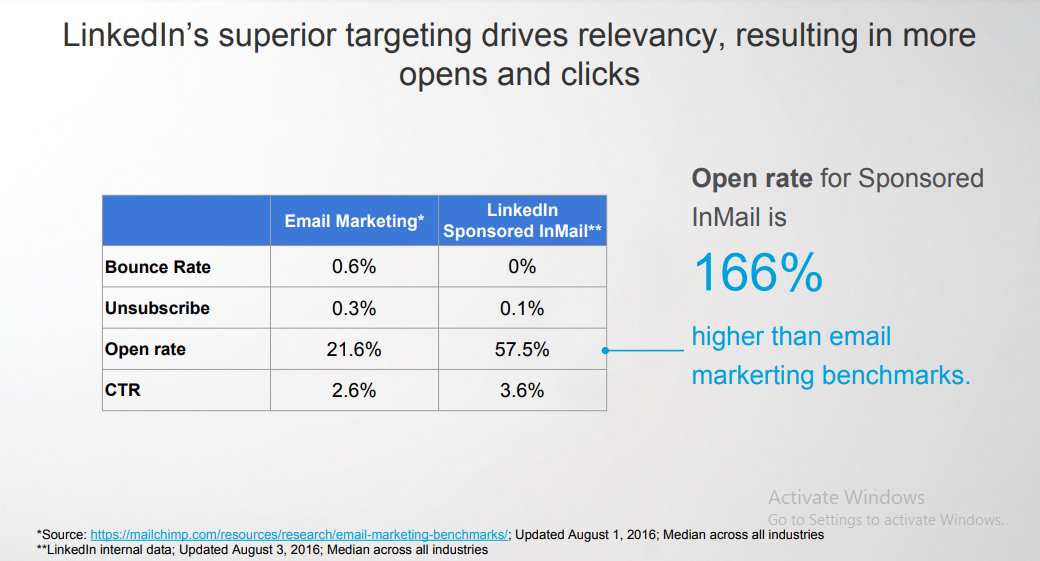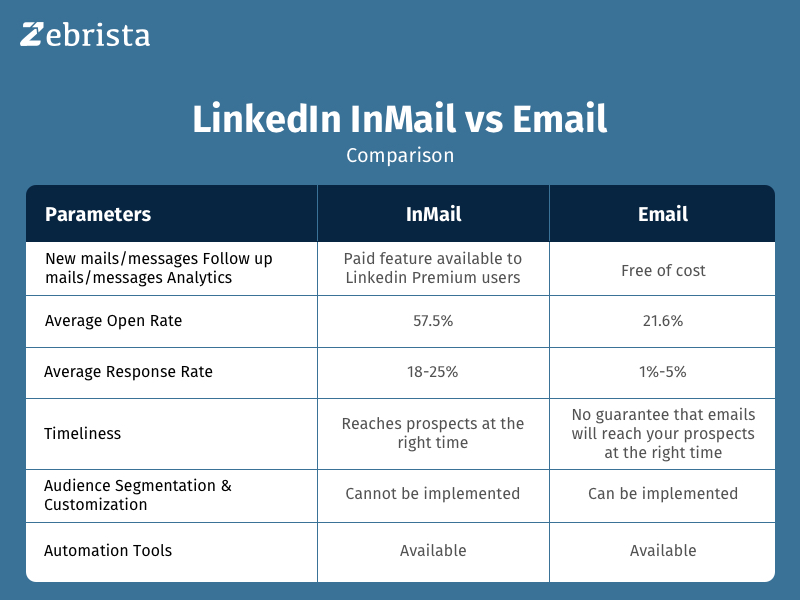LinkedIn InMail vs Email - Which works best for B2B Sales?
We went through the pros and cons of Email Marketing and LinkedIn Outreach Marketing for lead generation in one of our previous blogs. Each has its own target area and should be implemented only after proper analysis and research of which is more suitable according to a business’ requirements.
One of LinkedIn Outreach’s important and must-have approaches is that of InMail. InMail is a premium feature in LinkedIn Sales Navigator that is used to send direct messages/mails to other LinkedIn users (who are not part of your network) without sending a connection request first, which otherwise is not possible. With the InMail feature, it is possible for the Sales teams to reach out to people outside their network, thus expanding the scope of their opportunities and creating relationships with potential leads.
InMail and regular emails are often pitted against each other - to compare the effectiveness, growth and results each strategy brings to a company by generating more qualified leads. Email Marketing helps you reach thousands of prospects at a time, and is the most popular and effective form of communication even today whereas Linkedin InMail helps businesses connect with new prospects who were once out of reach.
But the million dollar question is - InMail or Email - which works best for B2B Sales? Let us compare both these techniques against various parameters to determine which of these should be chosen for generating qualified leads.
LinkedIn InMail vs Email : Pricing/Free and Paid Features
Needless to say, emails are and will always be free of cost. You can send as many fresh emails as you want, as many follow-up emails as you want and it won’t cause you a single penny. Of course, ensure that you don’t look like a spammer! Also, contact discovery and data enrichment processes have become so advanced and feasible in today’s times thanks to technology; that it is very easy to extract email addresses and details of people. Which is why, email marketing is still a sought after marketing strategy and an effective way of communication with prospects.
While LinkedIn InMail is a terrific feature to connect to out-of-reach prospects, unfortunately, it comes with a price. InMail is a paid feature only available to Linkedin Premium users. You will need to subscribe to a LinkedIn Sales Navigator premium account (Core/Advanced/Advanced Plus) to access the InMail feature. Every month, 50 InMail credits are credited in your account which means you have a limit of sending up to 50 InMail messages per month. You are required to pay for every single message you send, be it a new message or a follow-up message.
But here’s some good news! LinkedIn puts back the credits of those messages, which have received a response within 90 days of the sent date, in your account. These credits can be collected and used for further InMail messaging. If you want to understand more about InMail crediting and renewal process in LinkedIn Sales Navigator, click here.
Whatever method you choose - InMail or Email, the purpose should be to gather qualified data. Therefore, it is important to track, analyze and study the results generated by the campaigns. This helps in understanding whether the technique is working as expected, how it is performing, if the results are tangible enough etc. And if not, how and what should be changed in the strategy to make it successful in the future. In both the above cases, it is possible to measure the effectiveness of the strategy.
There are several email marketing automation tools like Zebrista that help in tracking the open & response rate of emails, link clicks, reminders for follow ups, history and statistics of emails and much more. In fact, Zebrista, a sales acceleration and automation tool, provides a unique feature of automatically tracking URLs and links in emails and notifies you as & when a prospect opens the URL in the email in real time.
LinkedIn InMail also provides the facility to see and study the response rates of InMail messages in detail, using InMail Analytics. It is possible to extract data regarding the number of InMail messages that have received or not received a response, how many have been rejected or accepted etc. But as one would expect, InMail Analytics also is a paid feature.
LinkedIn InMail vs Email : Open and Response Rates
According to statistics, an average email open rate is somewhere around 21.6% as opposed to a whopping 57.5% in case of InMail.

- Image Source : LinkedIn
- Data Source : MailChimp
And as far as the response rates are concerned, 1%-5% is the widely accepted email response rate as compared to an 18-25% response rate for LinkedIn InMail. The credit for this is clearly attributed to LinkedIn’s growing number of users day by day. The more users on LinkedIn, the more are the chances of reaching qualified prospects via InMail. Understandably, InMail surpasses emails w.r.t marketing benchmarks.
LinkedIn InMail vs Email : Timeliness
Strike while the iron is hot - is something that is apt for LinkedIn InMail. When it comes to reaching prospects at the right time, InMail definitely has an upper hand over emails. The moment you see any connections who are active at the moment, you can send them your InMail message right away.
The same, obviously, is not true with email outreach. There is no guarantee that emails will reach your prospects at the right time. While there are ways to track the timings of when email open and response rates are the best; there is no positive outcome of the study yet and looks like it still is going to take a great deal of time.
(Visit https://zebrista.com/ to know more about Zebrista, a Sales automation software.)
LinkedIn InMail vs Email : Audience Segmentation & Customization
This is one area where Emails take the cake!
It is a waste of time and resources if Prospecting focuses entirely on one single prospect or on an entire clan of unqualified leads. Prospecting zeroes on ideal customers that match the campaign’s ICP and generate qualified prospects. But even these qualified prospects are huge in number and not everyone will appreciate a generalized and random email/ message that is sent out to thousands of others. These messages either end up in spam or get completely ignored by the recipients.
Emails facilitate audience segmentation and personalization. It is possible to segregate prospects based on their demographics, position in the company, their requirements etc. It also becomes easier to customize emails for different segments based on their likes and dislikes. Offers and plans based on a prospect’s previous activities, personal recommendations based on their interest, services that eliminate their pain points etc are more likely to capture the attention of the prospect. It is important that prospects feel connected and acknowledged rather than feeling one amongst many.
With InMail, the above is not possible.
Sending bulk emails or InMails is time consuming and laborious and it is practically impossible to accelerate the execution of these tasks without the help of automation tools.
There are plenty of email automation tools available in the market today that automate the entire process of email marketing right from sending bulk emails to prospects via scheduled and targeted campaigns, automatically triggering follow-ups, analyzing campaign performance etc.
Zebrista is one such sales automation software that saves precious time, facilitates personalized and customized emails and increases customer retention by effectively automating email marketing campaigns.
Zebrista, in combination with LinkedIn tools like Sales Navigator, automates the InMail messaging process, follow-ups as well as aids in measuring and analyzing the performance metrics of InMail campaigns.

LinkedIn InMail vs Email : Conclusion
Whether to use LinkedIn InMail or regular emails depends on what your goals and objectives, as a company, are. The purpose of your outreach strategy should be to generate qualified leads who could be your potential clients tomorrow, irrespective of the channel you choose.
Both InMail and Emails have their own benefits and limitations. While emails have been a trusted source of lead engagement and communication since time immemorial, InMail can help you connect with prospects on the largest business networking platform, LinkedIn.

